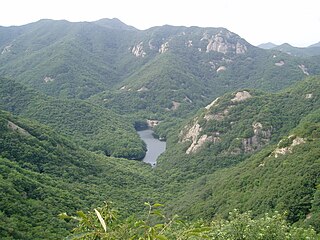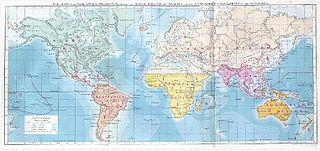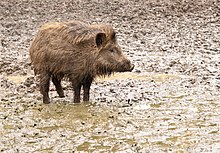
The Yellow Sea, also known as North Sea, is a marginal sea of the Western Pacific Ocean located between mainland China and the Korean Peninsula, and can be considered the northwestern part of the East China Sea.

The Pantanal is a natural region encompassing the world's largest tropical wetland area, and the world's largest flooded grasslands. It is located mostly within the Brazilian state of Mato Grosso do Sul, but it extends into Mato Grosso and portions of Bolivia and Paraguay. It sprawls over an area estimated at between 140,000 and 195,000 km2. Various subregional ecosystems exist, each with distinct hydrological, geological, and ecological characteristics; up to 12 of them have been defined.

Corcovado National Park is a National Park on the Osa Peninsula, in Osa Canton, located on the southwestern regions of Costa Rica, which is a part of the Osa Conservation Area. Corcovado National Park was established on October 24, 1975 and occupies an area of 424 square kilometres (164 sq mi). It is currently the largest park in Costa Rica and extends over about a third of the Osa Peninsula.

The environment of South Korea is the natural environment of South Korea, which occupies the southern half of the Korean peninsula. Environment - current issues: air pollution in large cities; water pollution from the discharge of sewage and industrial effluents; acid rain; drift net fishing.

Fauna of Azerbaijan or animal kingdom of Azerbaijan refers to the diversity of various types of animals, which inhabit and populate a defined ground or water area in Azerbaijan.

Pleistocene rewilding is the advocacy of the reintroduction of extant Pleistocene megafauna, or the close ecological equivalents of extinct megafauna. It is an extension of the conservation practice of rewilding, which aims to restore functioning, self-sustaining ecosystems through practices that may include species reintroductions.
The Korea Federation for Environmental Movements (KFEM) is a non-profit organization in South Korea that focuses on environmentalism.
The environment of Korea is the natural environment of the Korean peninsula. Some environmental conditions are relatively uniform throughout Korea, while others differ by region, and particularly between the peninsula's two countries: North Korea and South Korea.
The Gran Chaco is a plain of about 1.000.000 km2. It covers parts of Bolivia, Paraguay, Brazil and Argentina.

The Mobile–Tensaw River Delta is the largest river delta and wetland in Alabama. It encompasses approximately 260,000 acres (110,000 ha) in a 40-by-10-mile area and is the second largest delta in the contiguous United States. This large river delta is approximately 45 miles long and averages 8 miles wide, being 16 miles wide at its widest point. It covers approximately 300 square miles. Of its 260,000 acres, 20,000 acres consist of open water, 10,000 acres of marsh, 70,000 acres of swamp; and more than 85,000 acres of bottomland forest. It drains an area of about 44,000 sq miles, which includes 64% of Alabama and small portions of Georgia and Mississippi.
Bhopal is the capital of Madhya Pradesh state of India.

Salburua is a wetland habitat on the eastern outskirts of the city of Vitoria-Gasteiz in the Basque Country in Spain. The area, which is part of the city green belt, contains lakes, meadows and oak groves. It was drained in the 19th century to transform the area into farmland. Restoration work started in 1994 and has reversed this situation and now Salburua is a Ramsar Wetland of International Importance. The Salburua marshes are considered to be "the Basque country's most valuable area of wetland", according to a Fedenatur report for the European Commission in 2004.

Biogeographic classification of India is the division of India according to biogeographic characteristics. Biogeography is the study of the distribution of species (biology), organisms, and ecosystems in geographic space and through geological time. India has a rich heritage of natural diversity. India ranks fourth in Asia and tenth in the world amongst the top 17 mega-diverse countries in the world. India harbours nearly 11% of the world's floral diversity comprising over 17500 documented flowering plants, 6200 endemic species, 7500 medicinal plants and 246 globally threatened species in only 2.4% of world's land area. India is also home to four biodiversity hotspots—Andaman & Nicobar Islands, Eastern Himalaya, Indo-Burma region, and the Western Ghats. Hence the importance of biogeographical study of India's natural heritage.

The Korean fox, also known as the Korean red fox, is a subspecies of red fox that lives on Korean Peninsula, Russia, and Northeast China. It has a body length of 66–68 cm, a tail length of 42–44 cm and a weight of 4.1–5.9 kg.
The wildlife of Korea belongs to the Palearctic realm. Native or endemic species of the Korean Peninsula include Korean hare, Korean water deer, Korean field mouse, Korean brown frog, Korean pine and Korean spruce. The Korean Demilitarized Zone (DMZ) with its forest and natural wetlands is a unique biodiversity spot, which harbours 82 endangered species such as the red-crowned crane, Amur leopard and the Siberian tiger. Overall, DMZ is home to about 70 mammalian species, more than 300 birds and about 3,000 plants.
The wildlife of South Korea includes 8,271 plant species, 18,117 animal species and 3,528 species of fungi and others. 30,000 species are known to exist in South Korea, but it is estimated that there are more than 100,000 species.

Iberá National Park is a national park in Argentina located in the northeast province of Corrientes. The national park adjoins the 5,530 km2 Iberá Provincial Park to the southeast. The national park and provincial park are both within the Iberá Provincial Nature Reserve, a conservation area of 13,245 km2 created in 1982. The combined protected area is the largest in Argentina.
Sri Lanka exhibits a remarkable biological diversity and is considered to be the richest country in Asia in terms of species concentration.












